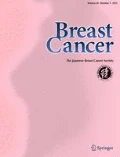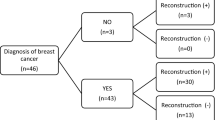Abstract
Background
Contralateral risk-reducing mastectomy (CRRM) for breast cancer patients with BRCA mutations has been reported to not only reduce breast cancer incidence but also to improve survival. The National Comprehensive Cancer Network guidelines recommend providing CRRM to women with BRCA mutations who desire CRRM after risk-reduction counseling. However, in Japan, CRRM cannot be performed generally because it is not covered by health insurance. Thus, we conducted a feasibility study to confirm the safety of CRRM.
Methods
CRRM with bilateral breast reconstructions were performed for breast cancer patients with BRCA mutations. The primary endpoint was early adverse events within 3 months, and secondary endpoints were late adverse events.
Results
Between August 2014 and November 2016, ten patients were enrolled. The median age was 37.5 years, and five of the patients had the BRCA1 mutation while five had the BRCA2 mutation. Six patients received neoadjuvant chemotherapy. Eight patients selected silicone breast implants, and two patients selected transverse rectus abdominis myocutaneous flap reconstruction. Pathological findings showed no evidence of occult breast cancers in any of the patients. At a median of 25.5 months follow-up time, CRRM-related early adverse events were hematoma (subsequently removed by re-operation; grade 2, n = 1), wound infection (grade 2, n = 1), skin ulceration (grade 1, n = 2) and wound pain (grade 1, n = 1). Overall, there were no grade 3 or more severe adverse events.
Conclusion
Our results confirm that CRRM with reconstruction could be performed safely.

Similar content being viewed by others
Abbreviations
- SBI:
-
Silicone breast implant
- LD:
-
Latissimus dorsi muscle transfer flap
- TRAM:
-
Transverse rectus abdominis myocutaneous flap
- TE:
-
Tissue expander
- CRRM:
-
Contralateral risk-reducing mastectomy
- RRSO:
-
Risk-reducing salpingo-oophorectomy
- Bt:
-
Total mastectomy
- SSM:
-
Skin sparing mastectomy
- NSM:
-
Nipple sparing mastectomy
- SLNB:
-
Sentinel lymph node biopsy
- Ax:
-
Axillary lymph node dissection
References
Mavaddat N, Peock S, Frost D, Ellis S, Platte R, Fineberg E, et al. Cancer risks for BRCA1 and BRCA2 mutation carriers: results from prospective analysis of EMBRACE. J Natl Cancer Inst. 2013;105:812–22.
Domchek SM, Friebel TM, Singer CF, Evans DG, Lynch HT, Isaacs C, et al. Association of risk-reducing surgery in BRCA1 or BRCA2 mutation carriers with cancer risk and mortality. JAMA. 2010;304:967–75.
Sugano K, Nakamura S, Ando J, Takayama S, Kamata H, Sekiguchi I, et al. Cross-sectional analysis of germline BRCA1 and BRCA2 mutations in Japanese patients suspected to have hereditary breast/ovarian cancer. Cancer Sci. 2008;99:1967–76.
Rebbeck TR, Friebel T, Lynch HT, Neuhausen SL, van’t Veer L, Garber JE, et al. Bilateral prophylactic mastectomy reduces breast cancer risk in BRCA1 and BRCA2 mutation carriers: the PROSE Study Group. J Clin Oncol. 2004;22:1055–62.
van Sprundel TC, Schmidt MK, Rookus MA, Brohet R, van Asperen CJ, Rutgers EJ, et al. Risk reduction of contralateral breast cancer and survival after contralateral prophylactic mastectomy in BRCA1 or BRCA2 mutation carriers. Br J Cancer. 2005;93:287–92.
Lostumbo L, Carbine NE, Wallace J. Prophylactic mastectomy for the prevention of breast cancer. Cochrane Database Syst Rev. 2010; Cd002748.
Heemskerk-Gerritsen BA, Rookus MA, Aalfs CM, Ausems MG, Collee JM, Jansen L, et al. Improved overall survival after contralateral risk-reducing mastectomy in BRCA1/2 mutation carriers with a history of unilateral breast cancer: a prospective analysis. Int J Cancer. 2015;136:668–77.
Evans DG, Ingham SL, Baildam A, Ross GL, Lalloo F, Buchan I, et al. Contralateral mastectomy improves survival in women with BRCA1/2-associated breast cancer. Breast Cancer Res Treat. 2013;140:135–42.
National Comprehensive Cancer Network NCCN. Clinical practice guidelines in oncology breast cancer risk reduction ver1. 2017.
Munabi NC, Olorunnipa OB, Goltsman D, Rohde CH, Ascherman JA. The ability of intra-operative perfusion mapping with laser-assisted indocyanine green angiography to predict mastectomy flap necrosis in breast reconstruction: a prospective trial. J Plast Reconstr Aesthet Surg. 2014;67:449–55.
Komorowska-Timek E, Gurtner GC. Intraoperative perfusion mapping with laser-assisted indocyanine green imaging can predict and prevent complications in immediate breast reconstruction. Plast Reconstr Surg. 2010;125:1065–73.
Manning AT, Sacchini VS. Conservative mastectomies for breast cancer and risk-reducing surgery: the Memorial Sloan Kettering Cancer Center experience. Gland Surg. 2016;5:55–62.
Colwell AS, Tessler O, Lin AM, Liao E, Winograd J, Cetrulo CL, et al. Breast reconstruction following nipple-sparing mastectomy: predictors of complications, reconstruction outcomes, and 5-year trends. Plast Reconstr Surg. 2014;133:496–506.
Hagen AI, Maehle L, Veda N, Vetti HH, Stormorken A, Ludvigsen T, et al. Risk reducing mastectomy, breast reconstruction and patient satisfaction in Norwegian BRCA1/2 mutation carriers. Breast. 2014;23:38–43.
Metcalfe K, Lynch HT, Ghadirian P, Tung N, Olivotto I, Warner E, et al. Contralateral breast cancer in BRCA1 and BRCA2 mutation carriers. J Clin Oncol. 2004;22:2328–35.
Graeser MK, Engel C, Rhiem K, Gadzicki D, Bick U, Kast K, et al. Contralateral breast cancer risk in BRCA1 and BRCA2 mutation carriers. J Clin Oncol. 2009;27:5887–92.
Pierce LJ, Phillips KA, Griffith KA, Buys S, Gaffney DK, Moran MS, et al. Local therapy in BRCA1 and BRCA2 mutation carriers with operable breast cancer: comparison of breast conservation and mastectomy. Breast Cancer Res Treat. 2010;121:389–98.
Rebbeck TR, Kauff ND, Domchek SM. Meta-analysis of risk reduction estimates associated with risk-reducing salpingo-oophorectomy in BRCA1 or BRCA2 mutation carriers. J Natl Cancer Inst. 2009;101:80–7.
Meijers-Heijboer H, van Geel B, van Putten WL, Henzen-Logmans SC, Seynaeve C, Menke-Pluymers MB, et al. Breast cancer after prophylactic bilateral mastectomy in women with a BRCA1 or BRCA2 mutation. N Engl J Med. 2001;345:159–64.
Heemskerk-Gerritsen BA, Menke-Pluijmers MB, Jager A, Tilanus-Linthorst MM, Koppert LB, Obdeijn IM, et al. Substantial breast cancer risk reduction and potential survival benefit after bilateral mastectomy when compared with surveillance in healthy BRCA1 and BRCA2 mutation carriers: a prospective analysis. Ann Oncol. 2013;24:2029–35.
Falco G, Rocco N, Bordoni D, Marano L, Accurso A, Buccelli C, et al. Contralateral risk reducing mastectomy in non-BRCA-mutated patients. Open Med (Wars). 2016;11:238–41.
Sacchini V, Pinotti JA, Barros AC, Luini A, Pluchinotta A, Pinotti M, et al. Nipple-sparing mastectomy for breast cancer and risk reduction: oncologic or technical problem? J Am Coll Surg. 2006;203:704–14.
van Verschuer VM, Maijers MC, van Deurzen CH, Koppert LB. Oncological safety of prophylactic breast surgery: skin-sparing and nipple-sparing versus total mastectomy. Gland Surg. 2015;4:467–75.
Headon HL, Kasem A, Mokbel K. The oncological safety of nipple-sparing mastectomy: a systematic review of the literature with a pooled analysis of 12,358 procedures. Arch Plast Surg. 2016;43:328–38.
Acknowledgements
We thank all the patients and investigators who participated in this study.
Author information
Authors and Affiliations
Corresponding author
Ethics declarations
Conflict of interest
The authors have no conflicts of interest to declare.
About this article
Cite this article
Yoshimura, A., Okumura, S., Sawaki, M. et al. Feasibility study of contralateral risk-reducing mastectomy with breast reconstruction for breast cancer patients with BRCA mutations in Japan. Breast Cancer 25, 539–546 (2018). https://doi.org/10.1007/s12282-018-0850-z
Received:
Accepted:
Published:
Issue Date:
DOI: https://doi.org/10.1007/s12282-018-0850-z



